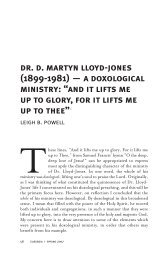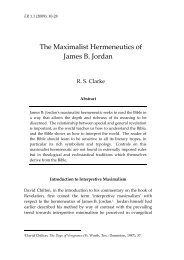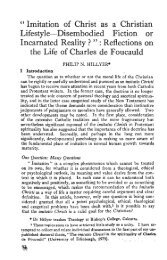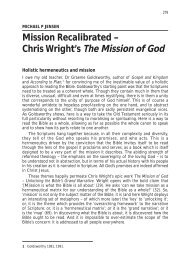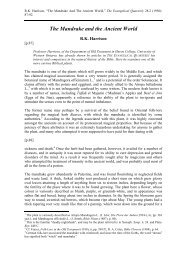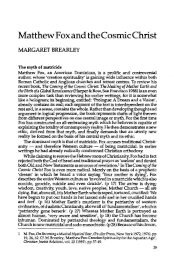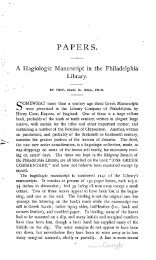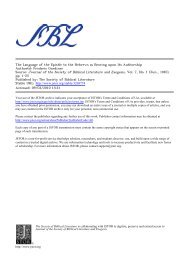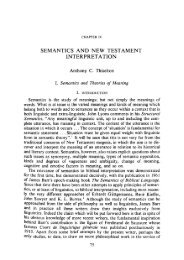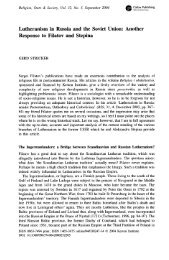Ancient Orient and Old Testament - BiblicalStudies.org.uk
Ancient Orient and Old Testament - BiblicalStudies.org.uk
Ancient Orient and Old Testament - BiblicalStudies.org.uk
Create successful ePaper yourself
Turn your PDF publications into a flip-book with our unique Google optimized e-Paper software.
K.A. Kitchen, <strong>Ancient</strong> <strong>Orient</strong> <strong>and</strong> <strong>Old</strong> <strong>Testament</strong>. London: Inter-Varsity Press, 1966. Hbk. pp.191.<br />
document referring to such a person or event is not in itself a valid or sufficient ground for doubting<br />
the historicity of the person, event, etc. concerned.<br />
For example, the Egyptian Fourteenth Dynasty consisted of about seventy-six kings (Manetho’s<br />
figure) mostly listed in the Turin Papyrus of Kings which dates from about 500 years after that period<br />
(Nineteenth Dynasty). So far, hardly a single definitely contemporary monument of any of these<br />
Delta kings<br />
[p.31]<br />
has been recovered (unlike the Memphite/Theban Thirteenth Dynasty), but Egyptologists are not so<br />
naive as to make this a reason for denying the existence of this line of kings. 37 So, although we have<br />
no contemporary record of the Abraham of Genesis, this likewise is not a sufficient reason for<br />
doubting his real existence. The absolute realism of his social activities as shown by cuneiform<br />
documents of the early to middle second millennium BG (see below, pp. 153 f .) is a warning that<br />
any such doubt must be founded on more tangible evidence if it is to be worth any consideration at<br />
all. We must have more positive, tangible reasons for doubt. 38 Most Egyptologists had too hastily<br />
dismissed Manetho’s Nephercheres in the Twenty-first Dynasty as fiction - until Montet’s<br />
excavations at Tanis suddenly revealed the existence of King Neferkare° Amenemnisu; 39 Manetho’s<br />
Osochor of the same dynasty has now also been restored to history. 40 However, the King Ramesses of<br />
the ‘Bentresh Stela’ is known never to have existed: three parts of his titulary are those of Tuthmosis<br />
IV, <strong>and</strong> both his cartouches <strong>and</strong> the story of the stela are based on those of Ramesses II <strong>and</strong> on events<br />
in his reign. 41<br />
It must always be remembered that such absence of evidence<br />
[p.32]<br />
in these fields of study too often merely reflects the large gaps in our present-day knowledge. How<br />
great are the gaps in our knowledge even of the relatively well documented culture of <strong>Ancient</strong> Egypt,<br />
<strong>and</strong> how negative evidence can distort our perspective, has been vividly demonstrated by Professor<br />
37 Cf. J. von Beckerath, Untersuchungen zur politischen Geschichte der zweiten .Zwischenzeit in Ägypten, 1965,<br />
pp. 1-11 (on sources <strong>and</strong> methods), <strong>and</strong> contrast material for the Thirteenth Dynasty (pp. 226-262) with that for<br />
the Fourteenth (pp. 262-269).<br />
38 Cf. my paper, ‘Historical Method <strong>and</strong> Early Hebrew Tradition’, THB 17 (1966), pp. 63-97; <strong>and</strong> R. de Vaux,<br />
‘Method in the Study of Early Hebrew History’ in J. P. Hyatt (ed.), The Bible in Modern Scholarship, 1965, pp.<br />
15-29. G. Björkman, ‘Egyptology <strong>and</strong> Historical Method’, <strong>Orient</strong>alia Suecana 13 (1964), pp. 9-33, is<br />
interesting <strong>and</strong> salutary, but errs fatally in hypercriticism of sources (pp. 11, 32-33). He is incapable of<br />
positively ‘faulting’ Merikarē’, his chosen text, <strong>and</strong> fails to realize the sheer inadequacy of ‘negative evidence’.<br />
See also examples of ‘negative evidence’, p. 44, note 47, below.<br />
39 See B. Grdseloff, ASAE 47 (1947), pp. 207-211; P. Montet, Psousennès, 1951, p. 185.<br />
40 Cf. E. Young, Journal of the American Research Center in Egypt 2 (1963), pp. 99-101; Kitchen, Chronique<br />
d’Ägypte 40/Fasc. 80 (1965), pp. 320-321, <strong>and</strong> Third Intermediate Period in Egypt (forthcoming).<br />
41 See W. Spiegelberg, RT 28 (1906), p. 181; G. Lefebvre, Romans et Contes Égyptiens, 1949, pp. 221-232<br />
(introduction, references, translation).




